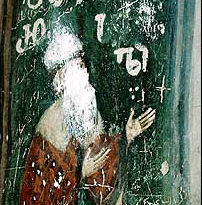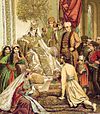Shota Rustaveli
Shota Rustaveli შოთა რუსთაველი | |
|---|---|
 Fresco of Rustaveli in theMonastery of the Crossin Jerusalem | |
| Born | Rustavi,Meskheti Kingdom of Georgia |
| Died | Jerusalem |
| Resting place | Monastery of the Cross Jerusalem(undisclosed) |
| Pen name | Rustveli Meskhetianpoet |
| Occupation | poet,thinker,statesman,prince,treasurer |
| Language | Middle Georgian |
| Nationality | Georgian |
| Citizenship | Kingdom of Georgia |
| Alma mater | Gelati academy Ikalto academy Academy inByzantine Empire |
| Period | Reign of QueenTamar Georgian Golden Age |
| Genre | poetry,national epic |
| Notable works | The Knight in the Panther's Skin |
Shota Rustaveli(Georgian:შოთა რუსთაველი,c. 1160– after c. 1220),[1]mononymouslyknown simply asRustaveli,was a medievalGeorgianpoet. He is considered to be the pre-eminent poet of theGeorgian Golden Ageand one of the greatest contributors toGeorgian literature.Rustaveli was the author ofThe Knight in the Panther's Skin,a Georgian nationalepic poem.
Biography
[edit]Little, if anything, is known about Rustaveli from contemporary sources. Shota Rustaveli was born in 1166. He started servingQueen Tamaras a Minister of Finance in 1191. His poem itself, namely the prologue, provides a clue to his identity: the poet identifies himself as "a certain Rustveli." "Rustveli" is not a surname, but a territorial epithet that can be interpreted as "of/from/holder of Rustavi"; although a 10th century manuscript fragment found in 1975 inSaint Catherine's Monasteryin Sinai attests to its use as a cognomen by a noble house of Ru(i)staveli.[2]Later Georgian authors from the 15th through 18th centuries are more informative; they are almost unanimous in identifying him as Shota Rustaveli, a name that is preserved on a fresco and a document from the formerly GeorgianMonastery of the Holy CrossatJerusalem.The fresco was described by the Georgian pilgrimTimote Gabashviliin 1757/58 and rediscovered by a team of Georgian scholars in 1960. The same Jerusalem document speaks of Shota as a sponsor of the monastery and amechurchletukhutsesi( "high treasurer" ), echoing a popular legend that Rustaveli was a minister atQueen Tamar’s court and retired to the monastery at an advanced age.
Both a folk tradition and the 17th-century royal poetArchilidentify Rustaveli as a native of the southern Georgian region ofMeskheti,where his home village Rustavi was located (in modern-dayAspindza Municipality,not to be confused with the modern-day city ofRustavinearTbilisi). He is assumed to have been born between 1160 and 1165. A legend states that Rustaveli was educated at the medieval Georgian academies ofGelatiandIkalto,and then in "Greece"(i.e., theByzantine Empire). He must have produced his major work no earlier than the 1180s and no later than the first decade of the 13th century, most probably 1205-1207. Shota Rustaveli died between 1245 and 1250.
Rustaveli was well acquainted withPersian"and was therefore able to read and appreciateits poetrywithout having to resort to faulty translations ".[3]Rustaveli may have composed Persian verse as well.[3]
The Knight in the Panther's Skin
[edit]The Knight in the Panther's Skinhas been translated into many languages. It was first printed in 1712 in the Georgian capitalTbilisi.The manuscripts ofThe Knight in the Panther's Skinoccupy an important place among the works produced in Georgia.
Two folios of this text, dating from the 16th century, are located in theGeorgian National Center of Manuscriptsin Tbilisi, and some lines of the poem from the 14th century are also held there. All other copies of the poem date from the 17th century.
Rustaveli mural portrait in Jerusalem
[edit]
The only known contemporary portrait of Shota Rustaveli was painted on the eastern face of the southwest pillar of the church of theMonastery of the Holy Crossin Jerusalem. It is set at the foot of two much larger images of saints and is accompanied by a Georgian-language inscription.
The portrait was vandalized in June 2004 by an unknown perpetrator, who scratched out Rustaveli's face and part of the accompanying Georgian inscription with his name. Georgia officially complained to Israel after the priceless fresco was defaced.[4]The portrait and inscription have been restored.
Legacy
[edit]The highest Georgian state prize in the fields of art and literature is theShota Rustaveli State Prize.Tbilisi's main thoroughfare is Rustaveli Avenue. In Tbilisi, one can also find theRustaveli Theatre,theShota Rustaveli Institute of Georgian Literatureof theGeorgian National Academy of Sciences,theShota Rustaveli Tbilisi International Airportand theRustaveli metro station,among many other landmarks bearing his name.
Rustaveli has been featured on the 100Georgian laribill since the introduction of the currency in 1995. In 2001Israeland Georgia jointly issuedpostage stampsto honor Shota Rustaveli.
Streets in a number of cities in the former Soviet Union are named after Rustaveli, including inMoscow,Saint Petersburg(Russia),Kyiv,Lviv(Ukraine),Tashkent(Uzbekistan),Yerevan,Gyumri(Armenia), and elsewhere, such as pathway in Jerusalem, which leads to the Monastery of the Cross.
Mihály Zichy,a 19th-centuryHungarianpainter, rose to the rank of "national painter" in Georgia as he produced the classic illustrations that have been frequently used in editions of Rustaveli's poetry. A sculpture and a street commemorate Zichy's work in Tbilisi. Georgian composerTamara Vakhvakhishviliset Rustaveli's poetry to music in her compositionCitationfor voice and orchestra.
-
1938 Soviet stamp
-
2016 100Georgian lariBanknote depicting Rustaveli
-
Rustaveli bust inRome
-
Tashkent, Uzbekistan
-
Memorial monument for Shota Rustaveli near theMonastery of the Holy Crossin Jerusalem
References
[edit]- ^Shota Rustaveli, Encyclopædia Britannica
- ^Aleksidze, Nikoloz (2018).Georgia: A Cultural Journey through the Wardrop Collection.Oxford: Bodleian Library. pp. 40–41.ISBN9781851244959.
- ^abFarmanfarmaian 2009,p. 26.
- ^"Precious Jerusalem fresco defaced".BBC. 5 July 2004.Retrieved6 August2022.
Sources
[edit]- Farmanfarmaian, Fatema Soudavar (2009).Arjomand, Saïd Amir(ed.). "Georgia and Iran: Three Millennia of Cultural Relations An Overview".Journal of Persianate Studies.2(1). BRILL: 1–43.doi:10.1163/187471609X445464.
External links
[edit]- On the first translation ofThe Knight in the Panther's skinfrom Georgian into Russian.
- The Man in the Panther's Skin:full text of M. Wardrop's English translation.
- Shota Rustaveli.The Knight in the Panther's Skin(fragments in English).
- Works by Shota RustaveliatLibriVox(public domain audiobooks)

- Illustrations by Sergo Kobuladze.
- Shota Rustaveli.Der Ritter im Tigerfell.(in German)
- Shota Rustaveli Institute of Georgian Literature of the Georgian Academy of Sciences.
- Eco, Umberto(2010)."Rustaveli, chi era costui?".L'Espresso.Retrieved28 September2017.
Literature
[edit]- Tite Margwelaschwili."Der Mann in Pantherfell".- "Georgica", London, 1936(in German)
- Zviad Gamsakhurdia."Tropology ofThe Knight in the Panther's Skin"(a monograph), Tbilisi, 1991, 352 pp (in Georgian, English summary)
- Shota Rustaveli.The Lord of the Panther-Skin,Albany: SUNY Press, 1977, 240 pp, translated by R.H. Stevenson, UNESCO Collection of representative works: Series of translations from the literatures of the Union of Soviet Socialist republics
- Shota Rustaveli.The Man in the Panther's Skin,London: The Royal Asiatic Society of Great Britain and Ireland, 1912, translated by Marjory Scott Wardrop, repr. 1966.
- Shota Rustaveli.The Knight in Panther Skin,London: The Folio Society, 1977, A free translation in prose by Katharine Vivian.
- Beynen, G. Koolemans. "Murder, Foul and Fair, in Shota Rustaveli'sThe Man in the Panther Skin ",inMedieval and Early Modern Murder,Larissa Tracy, ed. (Woodbridge: The Boydell Press, 2018), pp. 350–70.






